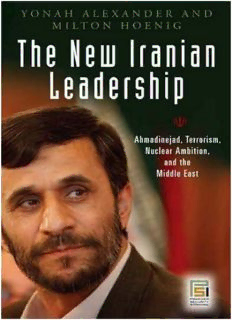
The New Iranian Leadership: Ahmadinejad, Terrorism, Nuclear Ambition, and the Middle East (Praeger Security International) PDF
Preview The New Iranian Leadership: Ahmadinejad, Terrorism, Nuclear Ambition, and the Middle East (Praeger Security International)
P1:RTJ GGBD169-FM C9639/Alexander TopMargin:5/8in GutterMargin:3/4in November17,2007 22:26 THE NEW IRANIAN LEADERSHIP i P1:RTJ GGBD169-FM C9639/Alexander TopMargin:5/8in GutterMargin:3/4in November17,2007 22:26 PraegerSecurityInternationalAdvisoryBoard BoardCochairs LochK.Johnson,RegentsProfessorofPublicandInternationalAffairs,SchoolofPublic andInternationalAffairs,UniversityofGeorgia(U.S.A.) PaulWilkinson,ProfessorofInternationalRelationsandChairmanoftheAdvisory Board,CentrefortheStudyofTerrorismandPoliticalViolence,Universityof St.Andrews(U.K.) Members AnthonyH.Cordesman,ArleighA.BurkeChairinStrategy,CenterforStrategicand InternationalStudies(U.S.A.) The´re`seDelpech,DirectorofStrategicAffairs,AtomicEnergyCommission,andSenior ResearchFellow,CERI(FoundationNationaledesSciencesPolitiques), Paris(France) SirMichaelHoward,formerChicheleProfessoroftheHistoryofWarandRegisProfessor ofModernHistory,OxfordUniversity,andRobertA.LovettProfessorofMilitaryand NavalHistory,YaleUniversity(U.K.) LieutenantGeneralClaudiaJ.Kennedy,USA(Ret.),formerDeputyChiefofStafffor Intelligence,DepartmentoftheArmy(U.S.A.) PaulM.Kennedy,J.RichardsonDilworthProfessorofHistoryandDirector,International SecurityStudies,YaleUniversity(U.S.A.) RobertJ.O’Neill,formerChicheleProfessoroftheHistoryofWar,AllSoulsCollege, OxfordUniversity(Australia) ShibleyTelhami,AnwarSadatChairforPeaceandDevelopment,Departmentof GovernmentandPolitics,UniversityofMaryland(U.S.A.) FareedZakaria,Editor,NewsweekInternational(U.S.A.) ii P1:RTJ GGBD169-FM C9639/Alexander TopMargin:5/8in GutterMargin:3/4in November17,2007 22:26 THE NEW IRANIAN LEADERSHIP Ahmadinejad,Terrorism,NuclearAmbition, andtheMiddleEast YONAH ALEXANDER AND MILTON HOENIG PRAEGERSECURITYINTERNATIONAL (cid:1) Westport,Connecticut London iii P1:RTJ GGBD169-FM C9639/Alexander TopMargin:5/8in GutterMargin:3/4in November17,2007 22:26 LibraryofCongressCataloging-in-PublicationData Alexander,Yonah. ThenewIranianleadership:Ahmadinejad,terrorism,nuclearambition,andthe MiddleEast/YonahAlexanderandMiltonHoenig. p. cm. Includesbibliographicalreferencesandindex. ISBN-13:978–0–275–99639–0(alk.paper) 1. Ahmadinejad,Mahmoud. 2. Presidents—Iran—Biography. 3. Iran—Politicsand government—1997– 4. Iran—Foreignrelations—1997– 5. Nuclearweapons—Iran. 6.Iran—Foreignrelations—MiddleEast. I.Hoenig,MiltonM. II.Title. DS318.84.A36A44 2008 955.06(cid:1)1092—dc22 2007039690 BritishLibraryCataloguinginPublicationDataisavailable. Copyright(cid:2)C 2008byYonahAlexanderandMiltonHoenig Allrightsreserved.Noportionofthisbookmaybe reproduced,byanyprocessortechnique,withoutthe expresswrittenconsentofthepublisher. LibraryofCongressCatalogCardNumber:2007039690 ISBN-13:978–0–275–99639–0 Firstpublishedin2008 PraegerSecurityInternational,88PostRoadWest,Westport,CT06881 AnimprintofGreenwoodPublishingGroup,Inc. www.praeger.com PrintedintheUnitedStatesofAmerica Thepaperusedinthisbookcomplieswiththe PermanentPaperStandardissuedbytheNational InformationStandardsOrganization(Z39.48–1984). 10 9 8 7 6 5 4 3 2 1 iv P1:RTJ GGBD169-FM C9639/Alexander TopMargin:5/8in GutterMargin:3/4in November17,2007 22:26 Contents Preface vii Acknowledgments xiii 1. HistoricalPerspectives 1 2. Iran’sGovernmentStructure 12 3. Iran’sLeadershipProfiles 24 4. State-SponsoredTerrorismandIran’sRole 47 5. Iran’sTerroristNetwork:HizballahandHAMAS 64 6. Iran’sNuclearAmbitions 111 7. Iran’sBallisticMissile,Chemical,andBiologicalCapabilities 176 AppendixI:Iran’sPoliciesandInternationalReaction 193 AppendixII:NuclearChronology 211 Acronyms 255 Notes 257 SelectedBibliography 311 Index 323 v P1:RTJ GGBD169-FM C9639/Alexander TopMargin:5/8in GutterMargin:3/4in November17,2007 22:26 vi P1:RTJ GGBD169-FM C9639/Alexander TopMargin:5/8in GutterMargin:3/4in November17,2007 22:26 Preface AnoldPersianproverbteachesusthat“eventsareconstantlyunlikeoneanother.” Indeed,historicalpatternscannotberepeatedbecausewhathasalreadyhappened in the past provides no assurances that tomorrow will bring similar or identical occurrences.Additionally,eachepochgivesbirthtoitsownleaders,policies,and actions in the struggle for power within and among nations. And yet, it is as- sumed that wise rulers can benefit from yesterday’s lessons, do what is prudent andaccountabletoconfrontimmediatechallenges,andunderstandthatthereare adverseconsequencesforcraftingandimplementingradicalstrategieswhenwar andpeaceareconcerned. Can the validity of this assumption be examined in light of the ancient and contemporaryexperiencesofIran,ShiiteIslam’smostsignificantgeopoliticaland economicpowerinboththeMiddleEastandthroughoutIslamdom? At the beginning of the twenty-first century, the published and unpublished recordofthisexperienceisdocumentedinavastoutpouringofliteratureonIran fromboth official and unofficial sources.Thousands of studies, reports,articles, and general works have been produced by scholars, reporters, and politicians focusingonvariousaspectsofabroadpanoply:Persianhistoryoriginatinginan- tiquity;theIslamicbackground,characterizedbytheunendingtheologicalconflict between the Shiites (partisans of Ali, Prophet Mohammed’s cousin and son-in- law) and the Sunnis (those who follow the tradition) that has lasted over 1,300 years; the Pahlavi dynasty personified by the rise and fall of Shah Mohammed RezaPahlavi;andtheemergenceofthenewtheocraticregimeinTehranunderthe Ayatollahssince1979.1 WhatisofgraveconcerntotheworldcommunityareIran’srolesininterna- tionalterrorismanditsdevelopmentofweaponsofmassdestruction,particularly vii P1:RTJ GGBD169-FM C9639/Alexander TopMargin:5/8in GutterMargin:3/4in November17,2007 22:26 viii preface theregime’sexpandingnuclearprogram.Thesechallengeshavebeenintensified with the election of President Mahmoud Ahmadinejad in 2005. Since assuming office,thenewIranianleaderhasreversedtheseeminglymoremoderatepoliciesof hispredecessorsandprojectedhimselfontotheinternationalscenewithheadline- grabbingstatementsandspeechesregardingtheStateofIsraelandJudaism,open defianceofUNSecurityCouncilresolutionsdirectedatIran’snuclearcapabilities, and antagonism toward the interests of the United States, the European Union, andotherstatesintheMiddleEast,potentiallyleadingtotragicconsequencesfor allconcerned. Ahmadinejad’sapparentvisionofhiscountrybecomingthedominantpower in the region, capable of expanding its terrorist-sponsored activities in Iraq, Lebanon, and the Palestinian territories is only one of the latest examples of Iran’s nearly three-decades-long record of the “wild card” in the international system. Perhaps the most disturbing dangers posed by contemporary Iran under Ahmadinejadarethoserelatingtothesafety,welfare,andrightsofordinarypeople intheMiddleEast;thestabilityofthestatesystemintheregion;themovement towarddemocracy;andperhapseventhesurvivalofcivilizationitself. ThisbookisnotacomprehensivehistoryofPersia-Iranfromtimeimmemo- rial.Ratheritisanefforttoprovideaprofileofthecurrentleadership’spolicies andactionsagainstthebackgroundofitsrecordsincethefalloftheShahandthe ensuingconfrontationwiththeUnitedStates,the“greatSatan,”asperceived by the Ayatollahs and most recently depicted by Ahmadinejad and the new Iranian rulers. Therationaleforundertakingsuchastudyseemsself-evidentinlightofthe complexityoftherelationshipbetweenShiitetheologyofapocalypticvisionsthat seeuniversalchaosinpreparationforthereturnoftheHiddenImamandnonreli- giouspoliticaldecision-makingsuchasthemotivationsforIran’ssecuritypolicies, includingterrorismsponsorshipandnuclearprogramdevelopment.Afterall,the Shia-SunniandPersian-Arabtensionsandconflictsonlyunderscoreonesegment ofthenatureoftheIranianchallengetotheentireinternationalcommunity.Better understandingoftheextentofthereligious,political,andmilitaryrolesofPres- identAhmadinejadandtheSupremeLeaderAyatollahAliKhamenei,aswellas otherindividualsoperatingwithinthegovernmentstructure,isanimportantele- mentincraftingacoherentandrealisticstrategyincopingwithTehran’sdangers facingtheMiddleEastandotherregions. Thebookisdividedintosevenchapters,dealingwithaspectsofIran’shistory, governmental structure, leadership profiles, state-sponsored terrorism, terrorist networks (focusing on Hizballah and Hamas), nuclear ambitions, and military capabilities (ballistic missiles: chemical, and biological). Two appendices are provided.ThefirstincludestherecordofIran’sleadershippolicypronouncements andtheinternationalreactionstothenuclearcrisis.Thesecondappendixconsists ofanuclearchronologyfromAugust2002toJuly2007.Aselectedbibliography, asareferenceforfurtherstudyandresearch,aswellasanindexareincorporated inthevolume. P1:RTJ GGBD169-FM C9639/Alexander TopMargin:5/8in GutterMargin:3/4in November17,2007 22:26 preface ix Sincethemanuscriptwassubmittedtothepublisherinlatesummer2007,a numberofrecentdevelopmentsinSeptemberandOctoberhavebeennoteworthy. A brief selection of policies and actions of Iran, several states, and the United Nationsfollows. A.Iran (cid:1) President Ahmadinejad boasted that Iran is running more than 3,000 centrifugesusedtoenrichuraniumandisinstallingmoreeveryweek.2 (cid:1) Iran’s Foreign Ministry warned that itwill review its cooperation with the International Atomic Energy Agency to consider “new options” if theUNSecurityCouncilpassedathirdsanctionsresolution.3 (cid:1) Ayatollah Ali Khamenei replaced Yahya Rahim Safavi, who served as chief commander of the Islamic Revolutionary Guard Corps (IRGC), withGeneralMohammedAliAzizJafari(whocommandedtheRevolu- tionaryGuardsgroundforcesforthirteenyears).4 (cid:1) AyatollahAliKhameneicomparedPresidentGeorgeW.BushtoAdolf Hitlerandpredictedthathewouldeventuallybebroughttotrialasawar criminal.5 (cid:1) AnIranianWebsite,affiliatedwiththeTehranregime,reportedthat600 IranianShihab-3missileswerepointedattargetsthroughoutIsrael.6 (cid:1) PresidentAhmadinejad,inatelevisionprogram,appealedtotheAmer- icanpeoplesayingthathewantedpeaceandfriendshipwiththeUnited Statesdespitemountingtensionsbetweenthetwocountries.7 (cid:1) At a speech at the United Nations General Assembly, President Ah- madinejad stated that he considered the dispute over his country’s nu- clear program “closed” and vowed to disregard the resolutions of the SecurityCouncil,whichhesaidwasdominatedby“arrogantpowers.”8 (cid:1) AliLarijani,Iran’schiefnegotiator,whohasbeenakeyfigureinattempts tobrokeracompromisewiththeWestoverthenucleardispute,resigned, and was replaced by Saeed Jalili, possibly indicating a major shift in Tehran’spolicy.9 B.TheUnitedStates (cid:1) United States District Judge, Royce C. Lamberth, ruled that Iran must pay$2.65billiontothefamiliesofthe241Americanservicemenwho were killed in October of 1983 when two truck bombs struck the U.S. MarinebarracksinBeirut.10 (cid:1) In a Report to Congress on the Situation in Iraq, presented by the top U.S. commander in Iraq, General David H. Petraeus, it was observed that“Malignactions...especially,byIran”fuelviolenceundertakenby “foreignandhome-grownterrorists,insurgents,militiaextremists,and criminals.” General Petraeus specifically reported that “we have also disruptedShiamilitiaextremists,capturingtheheadandnumerousother leaders of the Iranian-supported Special Groups, along with a senior LebaneseHizballahoperativesupportingIran’sactivitiesinIraq.”11
Description: